A Comprehensive Guide to Wing Foil Boards: Craft and Technique
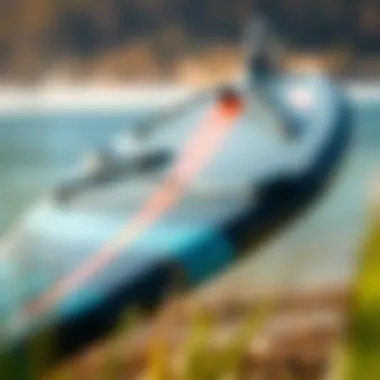
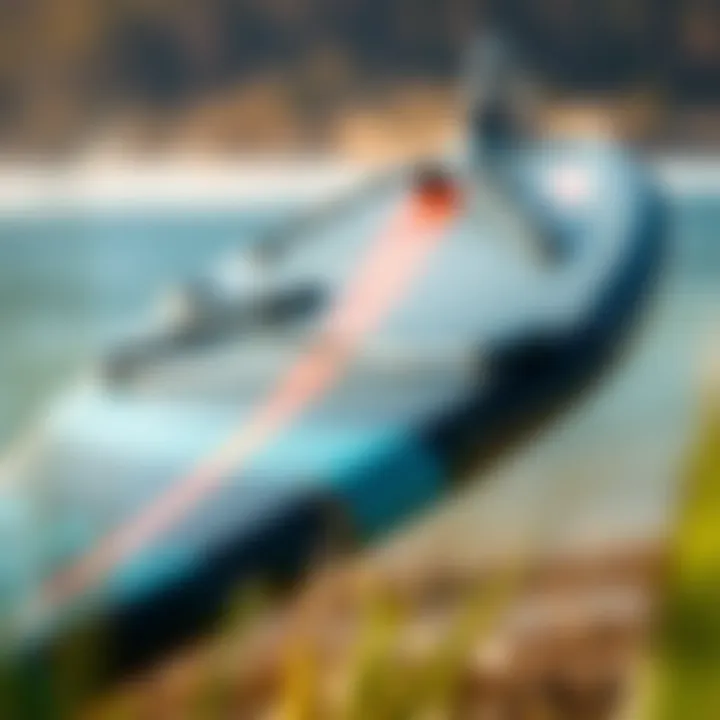
Intro
The world of wing foiling is exhilarating, combining elements of kiteboarding, windsurfing, and traditional surfing into a unified, fluid experience on the water. As this sport continues to gain traction, understanding the nuances of wing foil boards is key for both the casual enthusiast and the dedicated practitioner. This guide aims to break down complex topics related to gear selection, skill development, and safety considerations. By delving into these facets, riders of all levels can enhance their enjoyment and proficiency while connecting with the broader water sports community.
In this guide, we will explore:
- The types of equipment needed for wing foiling, including specific designs that match individual preferences and conditions.
- Essential skills and techniques necessary to progress in the sport.
- Maintenance tips that can prolong the life of your gear while ensuring optimal performance.
- Safety precautions and future trends in wing foiling that will keep you informed and prepared.
Let's kick things off by diving into the crucial aspect of gear selection.
Prelims to Wing Foil Boards
Wing foiling offers a fresh breeze in the world of water sports, appealing to those who thrive on adrenaline and the thrill of mastering a new skill. Essentially, this sport combines elements of windsurfing, kitesurfing, and stand-up paddleboarding, giving enthusiasts a unique way to glide across the water. Understanding wing foil boards is crucial not only for choosing the right equipment but also for grasping the fundamental techniques that lead to better performance.
The advantages of wing foiling are plentiful; from the freedom of movement to the sensation of flight just above the water, this sport can attract a diverse range of participants. It's not just about having fun on the water. Learning the nuances and intricacies of wing foiling can enrich one's experience significantly.
Discerning enthusiasts may wonder how best to select a wing foil board that aligns with their personal preferences and skill levels. Factors such as size, design, and materials play critical roles in performance and comfort, making knowledge of these elements essential. Additionally, understanding how the sport has evolved will enhance appreciation of modern developments in wing foiling technology and craftsmanship.
This guide gives an in-depth look into what wing foiling is all about and explores how it has transformed water sports. By delving into the anatomy of wing foil boards, the selection process, and mastering the art of wing foiling, it provides a well-rounded understanding for both newcomers and seasoned riders.
What is Wing Foiling?
Wing foiling is the marriage of a specially designed inflatable wing and a hydrofoil board that lifts riders above water. By holding the wing in their hands, riders harness wind energy to propel themselves across the water surface, while the hydrofoil reduces drag. This setup allows for a smooth glide, feeling almost like flying just above the waves. It's a relatively new sport, with roots tracing back to advancements in windsurfing and foiling technology.
Unlike traditional kiteboarding or windsurfing, wing foiling provides unmatched portability. The lightweight nature of the wings makes them easy to transport, while the absence of complicated equipment means one can get on the water faster. The simplicity doesn't detract from the tactics involved; riders still need to grasp the dynamics of wind direction, positioning, and balance to master the sport.
In essence, wing foiling is about navigating the water with finesse and control. Newcomers often find it surprisingly accessible; with a bit of practice, they can quickly graduate from novice to competent rider. In fact, many enthusiasts see it as a perfect blend of fun and challenge, offering both leisurely sails and thrilling rides in gusty conditions.
The Evolution of Water Sports
Water sports have come a long way, evolving significantly over the years. Historically, people engaged with the water primarily for utility or sustenance, using boats for fishing or transport. However, as time progressed, leisure became a driving factor, leading to the birth of recreational activities such as surfing, paddleboarding, and eventually, kiteboarding and windsurfing.
The development of hydrofoil technology represents a major leap in the evolution of these sports. This advancement saw riders lifted out of the water, reducing drag and enhancing speed, leading to unprecedented excitement among trailblazers in water sports. As different techniques and disciplines emerged, the demand for versatility in equipment grew, paving the way for innovations like wing foiling.
Emerging trends today reflect a shift towards user-friendly gear that invites participation from all skill levels. Wings are designed to be responsive and lightweight, addressing the needs of both beginners and experienced riders. This democratization of the sport invites a wider audience to engage with the water, fostering community events and competitive gatherings.
With a global community blossoming around wing foiling and a continuous influx of fresh approaches, it’s clear that the evolution of water sports is an ongoing journey. By understanding this context, participants can better appreciate their experiences on the water and connect with fellow enthusiasts.
The Anatomy of Wing Foil Boards
Understanding the architecture of wing foil boards is paramount for both novices and seasoned riders. This section provides an essential dive into the composite elements that define these boards, including the design features, materials, and dimensions that affect performance and enjoyment on the water.
Design Elements
Design of a wing foil board significantly influences its functionality and performance. The layout, including the shape and profile, can vastly alter the way a rider interacts with the water and wind.
- Hydrodynamics plays a crucial role. The bottom shape of the board, often designed with concave or flat surfaces, affects how efficiently it glides across the water. A well-shaped hull will allow for better speed and maneuverability.
- Rockers are also vital; they refer to the curve of the board from tip to tail. A board with a pronounced rocker can handle choppy water better, making it more suitable for rough conditions.
- Tail and Nose Shapes matter too. Rounded tails can give more lift and stability, while pointed noses might help cut through waves more efficiently.
Choosing a design that complements one’s riding style is key to an enjoyable experience. Whether a rider seeks speed, tricks, or stability, understanding these design elements can greatly enhance their time on the water.
Materials Used
The materials that comprise a wing foil board are essential for performance and durability. Each material has its own set of characteristics that impact weight, flex, and strength.
- Foam Cores: Most modern boards feature a foam core, which is lightweight and provides excellent buoyancy. Different types of foam can be utilized to tweak the board's stiffness and flex, influencing how it reacts during rides.
- Fiberglass: Often applied to create a tough outer shell, fiberglass increases the robustness of a board while maintaining a manageable weight. Some boards also employ carbon fiber for added strength and reduced weight, ideal for advanced riders seeking performance.
- Epoxy Resins: Used to bond materials together, epoxy resins ensure durability and responsiveness of the board while providing resistance to water damage. Protecting the inner components from moisture is crucial for longevity.
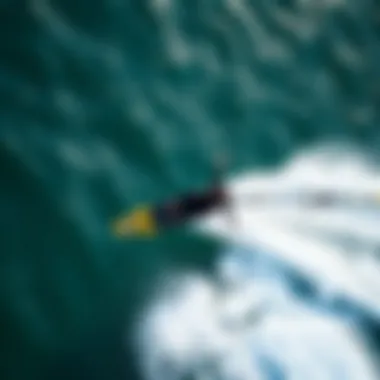
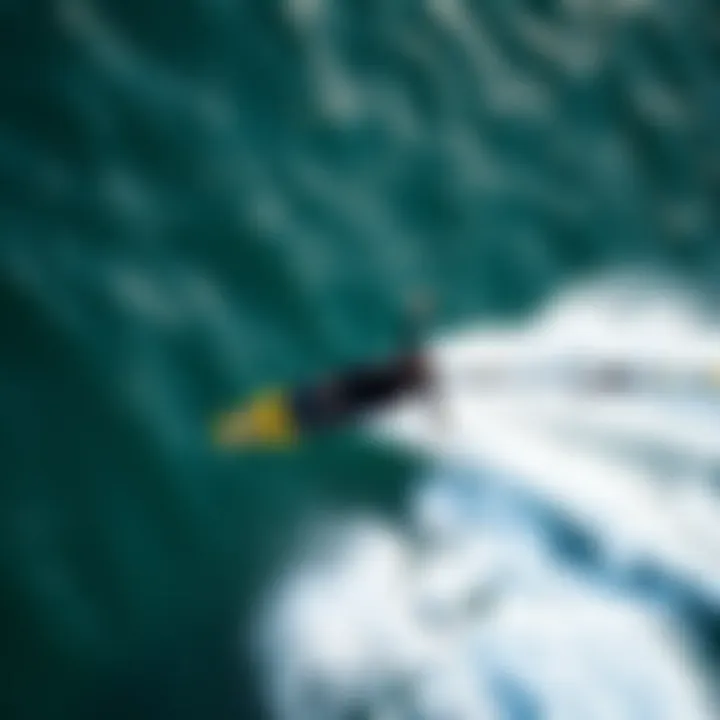
Selecting the right materials can lead to a more enjoyable and tailored riding experience. Riders should take into account their usual riding conditions and style when deciding on their board's composition.
Sizes and Shapes
Size and shape of wing foil boards are not merely aesthetic; they are pivotal determinants of performance.
- Length and Width: Boards typically range in length from about 4 to 8 feet, with wider boards offering increased stability, making them a good choice for beginners. Longer ones tend to provide better speed and tracking.
- Volume: This is a key metric, indicating how much buoyancy the board has. A board with higher volume can accommodate heavier riders or waves, while lower volume boards tend to be faster and more suited for advanced maneuvers.
- Tail Width: Wider tails assist with lift during take-off, while narrower tails can enhance speed but may require more skill to control.
It's crucial for riders to consider what types of conditions they'll encounter as well as their skill level. This intentional selection fosters an environment for improvement and success on the water.
As you explore wing foiling, remember: the right board can make all the difference between flight and flop.
Choosing the Right Wing Foil Board
Picking the right wing foil board is crucial for diving into this exhilarating sport. Whether you're a novice or a seasoned pro, a good choice can significantly enhance your experience on the water. In this section, we’ll break down how to consider different factors that come into play while selecting the board, along with the benefits each consideration can bring.
Skill Level Considerations
Your skill level acts as a compass when navigating through the myriad of options available. Beginners will likely appreciate wider boards that provide more surface area for stability. A board that is 5-6 feet in length often suits those just starting, as it offers greater balance and ease of use. In contrast, once you start turning heads with your skills, a more refined, smaller board like a 4-foot model might catch your eye. These deliver better maneuverability and speed but require a solid grasp on the fundamentals.
- Beginners: Look for stability, wider profiles
- Intermediate: Start experimenting with size and shape
- Advanced: Focus on performance and response time
Understanding your starting point is vital. Just as you wouldn't throw a guitar into the hands of a toddler expecting a symphony, choosing a board that matches your capabilities ensures you can grow while keeping safety top-of-mind.
Conditions and Environments
Next up, let’s get into how the environment dictates your choice in wing foil boards. Beach conditions can differ wildly — from flat lakes to frisky ocean waves, each presents unique challenges. If you’re aiming to skim over flat water, a shorter and wider board often works wonders for speed and fun. Conversely, in rougher waters or choppy conditions, a longer board may provide the necessary buoyancy and control.
Consider these environments:
- Flat Water: Opt for a larger, wider board.
- Waves: Search for boards designed for performance and agility.
- Windy Days: Go for a board that can handle gusty situations without losing stability.
Getting a feel of your local conditions will steer you towards the best equipment for your style. Without it, you might find yourself in a tricky situation, floundering in a choice that doesn't match the waves you ride.
Budget Analysis
Finally, let's tackle the often-awkward discussion: how much to spend? Setting a budget is paramount and can help focus your search without going around in circles. Wing foil boards can vary widely in price, starting from affordable options like the Naish Fly which caters to beginners and reaching up to elite models like the Duotone Foil Board.
When analyzing your budget, consider these:
- Entry-Level Boards: Generally range from $600 - $1,200.
- Mid-Range: Expect to pay between $1,200 - $2,000.
- High-End Models: Can go upwards of $2,000.
"Don’t let your eyes get bigger than your pocket. A smart investment today can make all the difference down the line."
It helps to balance quality with price rather than buying something just because it looks fancy or is the latest trend. Make a list of the boards that fit your criteria and compare them. This way, you won't just chase after shiny objects that might lead you astray.
Choosing the right wing foil board isn’t just about picking any old model off the shelf; it's about matching your skills, the environment, and, of course, your finances to enhance your overall experience in this thrilling endeavor.
Techniques for Mastering Wing Foiling
Mastering wing foiling is no easy task, but it can be incredibly rewarding. The techniques you learn will not only enhance your performance but also deepen your connection with the sport. Knowing how to maneuver effectively, maintain stability, and progress from basic to advanced techniques is key. The art of wing foiling combines physical skill, balance, and a good understanding of the wind and water conditions.
Basic Maneuvers
Every rider should start with the fundamentals of wing foiling. Basic maneuvers can make or break your experience. First, you need to get comfortable with the balance on the board. Here are some starter techniques:
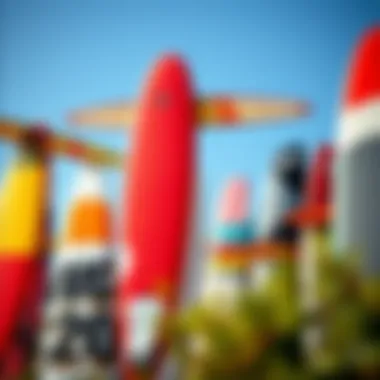
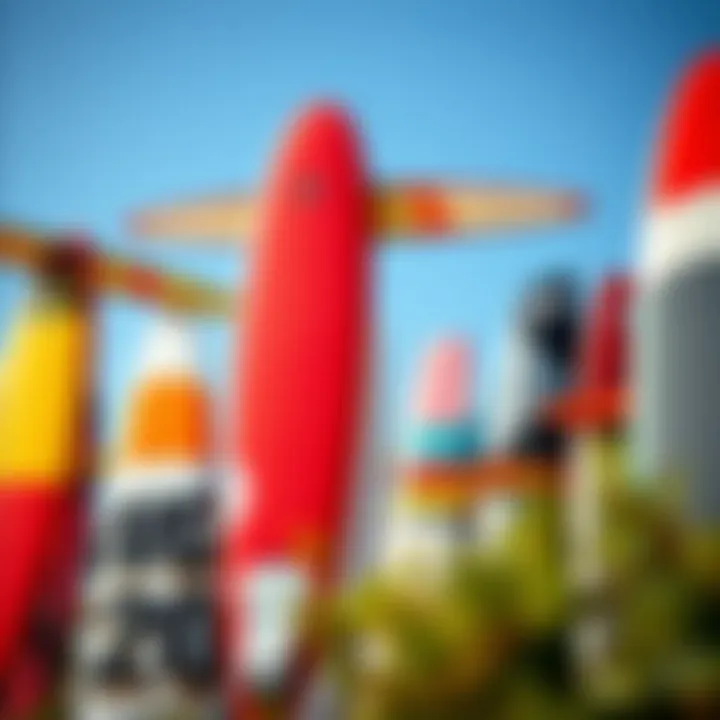
- Starting Off: Get upright on your board while holding the wing in front. Start with a slow build-up of speed, keeping your body centered. This can feel awkward at first, but practice makes it easier.
- Tacks and Jibes: Turning the board efficiently is a challenge for many. In tacks, you’ll swing the wing across your body while shifting your weight. In jibes, you're just making a turn downwind, allowing for a smoother sail transition.
- Stopping: Understanding how to come to a halt is just as important as moving. To stop, position the wing back and shift your weight back onto your heels.
The essence of these basic maneuvers lies in repetition. Every time you take to the water, focus on refining these skills. It’s a building block approach that cannot be overlooked.
Advanced Techniques
Once you're comfortable with the basics, it's time to evolve your skills and incorporate more advanced techniques:
- Carving Turns: This gives you a more dynamic ride. Lean into the turn while controlling the wing; it's about finding the right angle.
- Jumping: Learning to lift off the water can be exhilarating. Start by compressing your knees and then jumping off as you pull the wing. Timing and balance are crucial here.
- Freestyle Tricks: These can be fun and offer an expressive side to your riding. Basic tricks include spins, flips, and even hand drags. Knowledge of the wind and how it interacts with your board will inform your safety and success in these stunts.
Use of advanced techniques enhances not just your skill but also opens up possibilities for fun and creativity on the water. However, a solid understanding of your body's motion and the elemental conditions around you will significantly affect your performance.
Improving Stability and Control
Stability and control are vital for enjoying your wing foiling sessions. If you cannot manage these, you could find yourself face-down in the water more often than you'd like:
- Balance Practice: Engage in exercises focusing on balance. Stand on one leg or practice yoga. The more in tune you are with your center of gravity, the better you'll manage your board.
- Proper Foot Placement: Ensure your feet are positioned correctly. They should be shoulder-width apart, aligned with the board for optimal balance. This also allows for better weight distribution when you turn or jump.
- Wing Handling: Practicing different wing positions will aid your control. The angle at which you hold the wing affects both lift and drag, influencing how stable you feel on the board.
"Success in wing foiling is often found in the details, be it the angle of your wing or the posture of your body. The small adjustments make the biggest impact."
Improving stability and control isn't just about your time in the water. It's also about developing muscle memory and intuition, where each session adds to your growth as a rider.
Focusing on these techniques fosters both personal growth and community engagement. Once you grasp the art of wing foiling, the thrill of gliding over water will invigorate you, making this sport a lifelong journey of learning and excitement.
Safety Precautions in Wing Foiling
When it comes to wing foiling, safety isn't just a checkbox; it's the backbone of enjoying the sport. Committing to proper safety measures not only protects you but also enhances your overall experience on the water. Let's delve into some crucial aspects that every rider should be aware of to keep themselves and others safe.
Equipment Checks
Before hitting the waves, conducting thorough equipment checks is paramount. Wings, boards, and foils can be intricate and require regular maintenance to function properly. A quick rundown could include:
- Wings: Check for tears or punctures. A compromised wing can lead to unexpected drops and falls.
- Board: Examine for chips or dents on the bottom. These can affect glide and stability.
- Foil: Inspect for any signs of rust or wear on the mast and wings. Any defects here can alter your performance significantly.
- Safety Gear: Ensure that your helmet, impact vest, and leash are in good condition and fit well.
These precautionary checks might seem basic, but a little time spent here can mean the difference between a smooth ride and a trip to the hospital.
Environmental Awareness
Understanding the environment in which you are wing foiling is crucial. Each body of water has its own set of conditions that can drastically shape your safety. Pay attention to the following:
- Weather Conditions: A calm, sunny day may quickly turn windy or stormy. Monitor local forecasts and be ready to pack up if things don’t look good.
- Water Hazards: From rocks to reefs, identifying hazards beneath the surface is vital. Always know where the shallows are, as they can become dangerous if you're airborne.
- Other Water Users: Keep an eye on other people around you. Knowing where jetskis, boats, or surfers are can help avoid collisions.
Being informed can significantly reduce your risk and keep your experience enjoyable.
Emergency Procedures
Even the best-laid plans can go awry, so knowing what to do in an emergency is part and parcel of safe wing foiling. Familiarizing yourself with these procedures can save your skin.
- Lost Wing: If you lose hold of your wing, stay calm. Try to locate its position and steer your board in a safe direction, avoiding any obstacles.
- Swimmer Assistance: If you see someone in trouble, position yourself safely, and if possible, offer assistance. Signal for help, or direct other nearby users to the person in distress.
- Self-Rescue: If you find yourself separated from your board and the wind is strong, consider a self-rescue approach by swimming towards the board or using your wing to create a drag for better control.
"A stitch in time saves nine." Taking a moment to familiarize yourself with these procedures can be a real lifesaver.
In summary, safety in wing foiling is grounded in solid preparation, awareness of your surroundings, and knowledge of emergency protocols. When riders prioritize safety, they open the door to not only longevity in the sport but also a significantly more enjoyable experience on the water.
Maintenance and Care of Wing Foil Boards
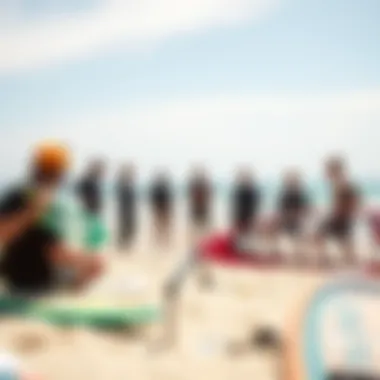

Taking proper care of your wing foil board is like tending to a well-loved instrument; it keeps the performance sharp and enhances your overall experience on the water. Much like a musician wouldn’t neglect their guitar, dedicated riders should understand that maintenance can prolong the life of the board and ensure better performance. Neglect can lead to costly repairs or worse—an unexpected mishap on the water.
Cleaning and Storage
After a thrilling day on the water, the last thing you might think about is cleaning your equipment, but it’s a crucial step. Saltwater, sand, and debris can wreak havoc on your board if left unattended.
- Rinse Thoroughly: Begin by rinsing your board with fresh, clean water. This simple act washes away salt and sand that could wear down the surface or corrode components.
- Dry It Off: After rinsing, dry the board with a soft cloth or towel to prevent any lingering moisture from causing mold or mildew. Make it a habit to give your wing a good wipe-down too, especially if it’s been exposed to sun and salt.
- Store Appropriately: When it comes to storage, don’t just toss the board into a corner. Find a cool, dry spot away from direct sunlight. Consider using a padded storage bag to protect your investment.
Following these steps helps keep your board in tip-top shape and ready for your next adventure.
Identifying Wear and Tear
Over time, even the best wing foil boards may show signs of wear. Recognizing these signs early can save you from unexpected service costs and improve safety on the water. Here’s what to watch for:
- Surface Scratches: Minor scratches might not seem significant, but they can start to affect performance or allow water to seep into layers. Check for deep gouges or cracks.
- Delamination: If you notice any bubbling or separation between layers, that’s a red flag. Delamination can compromise the integrity of the board.
- Fittings and Accessories: Regularly inspect the straps, footpads, and other components for cracks or deteriorating materials. These can impact stability and control.
By staying vigilant and checking these aspects, you ensure your board remains in good condition, allowing you to enjoy the sport without worries.
Repair Techniques
Even the best of us may face the occasional mishap, leading to minor damages that require some fixing up. Knowing how to repair your board can save you time and money.
- DIY Repairs: For small scratches and dents, a simple epoxy resin or dedicated repair kits can work wonders. Sand down the area, apply the epoxy, and let it cure as per the instructions.
- Professional Help: If damage is extensive, such as severe delamination or structural issues, reaching out to a professional repair shop is advisable. They can often restore boards to their former glory, ensuring safety and performance.
- Preventative Measures: Consider using protective film or guards that can help avoid damage in the first place. It's much easier (and cheaper) to protect than to repair.
Keeping your gear well-maintained not only enhances your performance but also fosters a greater sense of connection to the sport. The sea can be unpredictable, but your preparation shouldn’t be.
The Future of Wing Foiling
Wing foiling has carved a significant niche within the broader spectrum of water sports, and the future of this thrilling activity is looking bright. As new technologies and innovations emerge, enthusiasts are not only experiencing enhancements in performance but also witnessing a shift in how the sport is perceived. The allure of gliding seamlessly across the waves, all while harnessing the power of the wind, is capturing the enthusiasm of kiteboarders, instructors, and event organizers alike.
In this section, we explore what lies ahead in the world of wing foiling, focusing on innovative advancements and emerging trends that challenge what we currently understand about the sport.
Innovations on the Horizon
The technological advancements in wing foiling are akin to upgrading from horse-drawn carriages to sleek electric vehicles. We're talking about improvements that are set to redefine efficiency and performance on the water. For instance, the development of lightweight materials and aerodynamic designs in wings will likely reduce drag and increase speed. Manufacturers are already experimenting with hybrid materials that combine strength and flexibility, allowing for a more dynamic riding experience.
- Smart Technology Integration: The incorporation of sensors that provide real-time data could be revolutionary. Imagine wearing a wing that communicates with your smartwatch, providing feedback on wind strength, your speed, and even your balance. These technologies can educate riders, optimizing their performance live and leading to safer experiences.
- Modularity and Customization: Future boards may feature modular designs, where riders can swap out parts based on preference or conditions. Want a different wing size for a gusty day? Just switch out the component, instead of buying a whole new setup.
- Eco-friendly Materials: As sustainability becomes a priority, manufacturers are diving into eco-friendly materials. This could mean boards and wings made from recycled or biodegradable substances, allowing water lovers to enjoy their sport while caring for the planet.
The direction wing foiling is taking suggests that it's not just about fun out there anymore; it's about blending technology with nature for a richer experience.
Emerging Trends
As we glance into the future, certain trends are poised to make significant impacts in wing foiling. These include not only shifts in technique but also in community engagement and sporting events.
- Community-Driven Events: We are seeing an uptick in local and international competitions, enticing riders from all backgrounds and skills. Events like the Wing Foil World Cup are becoming more common, fostering a sense of global community while promoting healthy competition. The camaraderie that comes from these gatherings boosts participation and retains enthusiasts within the sport.
- Inclusive Initiatives: As wing foiling grows in popularity, there's a notable push towards inclusivity. Programs targeting women and youth seek to diversify participant demographics, breaking down barriers that had kept many adventurous spirits on land.
- Learning Resources: An expansive range of video tutorials and online courses offers new riders a leg up. This trend promotes self-education and enhances rider safety and effectiveness. As communities grow, so do the platforms through which knowledge is shared.
These aspects are intertwining with the existing fabric of wing foiling to create a promising future. The ongoing evolution doesn’t merely suggest a change; it heralds an experience that’s becoming richer and more accessible, ensuring that this sport continues to flourish for years to come.
Closure
As we reach the end of this comprehensive exploration of wing foil boards, it’s crucial to emphasize the importance of understanding the full spectrum of this sport. Wing foiling isn't just about gliding over water; it's a blend of art, science, and passion that combines skilled technique with the right equipment. This article has equipped you with key insights that can surely elevate your experience on the water, whether you're a curious beginner or a seasoned pro.
Recap of Key Points
- Definition and Evolution: We’ve ventured into the origins of wing foiling, tracing its roots and how it has become a dynamic addition to water sports, resonating with thrill-seekers and tranquility lovers alike.
- Board Anatomy: Understanding the structure and components of wing foil boards, including the materials, sizes, and shapes that cater to different skill levels and conditions, lays the foundation for making educated choices when selecting your gear.
- Techniques and Tips: From foundational maneuvers to advanced techniques, mastering these skills greatly enhances your performance and enjoyment. Learning how to control stability while riding a foil can make all the difference in your outings.
- Safety First: The section on safety precautions isn't merely a checklist; it’s an essential aspect of enjoying the sport. Environmental awareness and emergency preparedness can't be overstated when it comes to protecting yourself and your fellow riders.
- Maintenance Matters: Care for your equipment ensures longevity. Knowing how to clean, store, and address wear and tear of your wing foil board will prevent unnecessary headaches down the line.
- Looking Forward: Lastly, we discussed innovations and emerging trends that signal a bright future for wing foiling. This sport continues to evolve, offering new opportunities for connection within the global water sports community.
Encouragement for Continued Learning
As with any sport, the learning curve can be daunting, but it is made enjoyable through continuous practice and exploration. Do not see challenges as stumbling blocks but as stepping stones towards improvement. Delve into various resources:
- Engage with forums on websites like Reddit or find your tribe on social media platforms such as Facebook, where discussions thrive.
- Sign up for workshops or courses offered by local stores that focus on kiteboarding and wing foiling. These hands-on experiences provide invaluable insights that online articles may not convey.
- Attend competitions or social gatherings to connect with seasoned veterans and fellow enthusiasts. It's a great way to absorb tips firsthand, share stories, and cultivate camaraderie.
Harness the zeal for learning, and you will find that every session on the water not only builds your skills but also enriches your appreciation for this captivating sport. Remember, in the world of wing foiling, there’s always something new to discover. Happy foiling!















